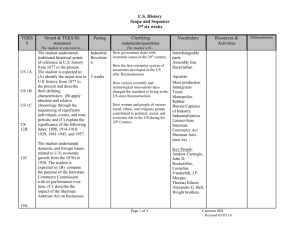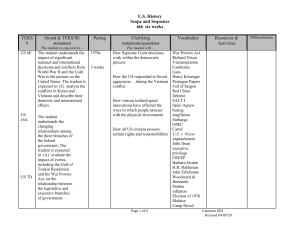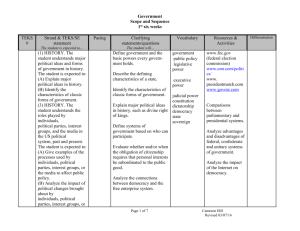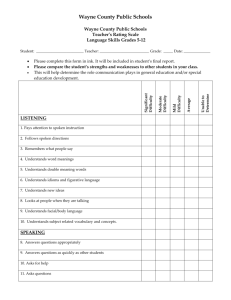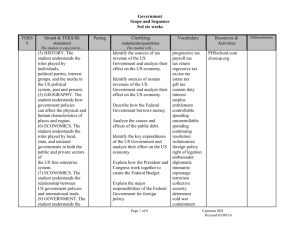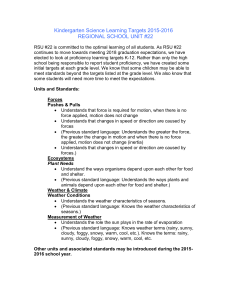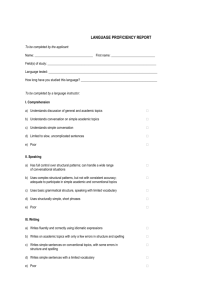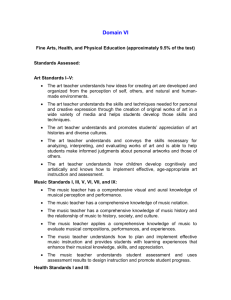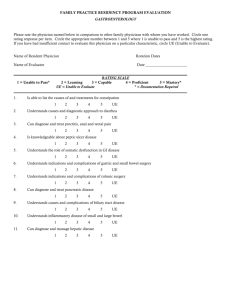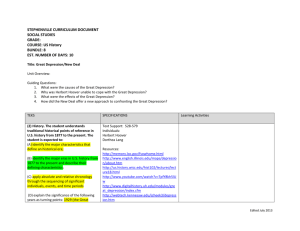The student is expected to…
advertisement
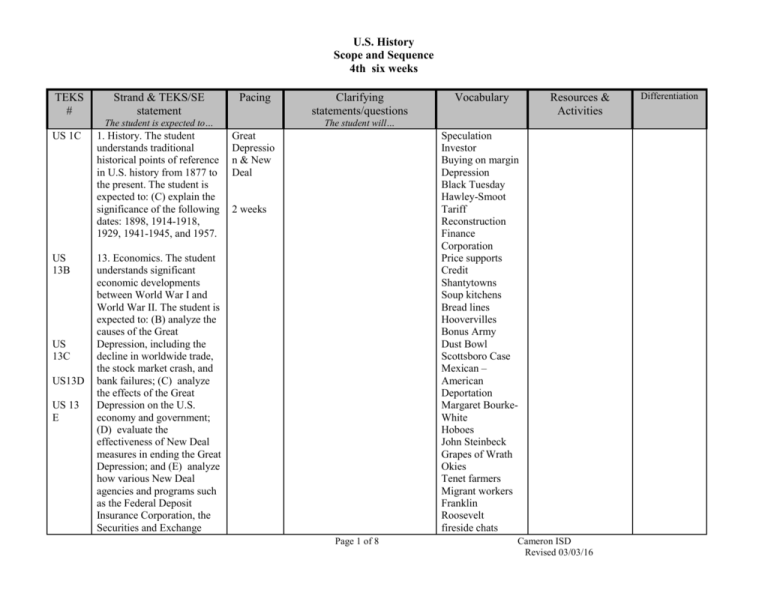
U.S. History Scope and Sequence 4th six weeks TEKS # Strand & TEKS/SE statement US 1C 1. History. The student understands traditional historical points of reference in U.S. history from 1877 to the present. The student is expected to: (C) explain the significance of the following dates: 1898, 1914-1918, 1929, 1941-1945, and 1957. Pacing The student is expected to… US 13B US 13C US13D US 13 E Clarifying statements/questions Vocabulary Resources & Activities The student will… Great Depressio n & New Deal Speculation Investor Buying on margin Depression Black Tuesday Hawley-Smoot Tariff Reconstruction Finance Corporation Price supports Credit Shantytowns Soup kitchens Bread lines Hoovervilles Bonus Army Dust Bowl Scottsboro Case Mexican – American Deportation Margaret BourkeWhite Hoboes John Steinbeck Grapes of Wrath Okies Tenet farmers Migrant workers Franklin Roosevelt fireside chats 2 weeks 13. Economics. The student understands significant economic developments between World War I and World War II. The student is expected to: (B) analyze the causes of the Great Depression, including the decline in worldwide trade, the stock market crash, and bank failures; (C) analyze the effects of the Great Depression on the U.S. economy and government; (D) evaluate the effectiveness of New Deal measures in ending the Great Depression; and (E) analyze how various New Deal agencies and programs such as the Federal Deposit Insurance Corporation, the Securities and Exchange Page 1 of 8 Cameron ISD Revised 03/03/16 Differentiation U.S. History Scope and Sequence 4th six weeks US 10A US 18A US 15A Commission, and Social Security continue to affect the lives of U.S. citizens. The New Deal (the 3 R’s) Glass-Steagall Act Federal Securities Act Agricultural Adjustment Act National Industrial Recovery Act Civilian Conservation Corp deficit spending Eleanor Roosevelt Works Progress Admin. Wagner Act (National Labor Relations Act) Social Security Act FDIC Securities and Exchange Commission Tennessee Valley Authority “pack the court” Huey P. Long Dorthea Lange Frances Perkins Mary McLeod Bethune Indian Reorganization Act of 1934 10. Geography. The student understands the effects of migration and immigration on American society. The student is expected to: (A) analyze the effects of changing demographic patterns resulting from migration within the United States. 18. Citizenship. The student understands efforts to expand the democratic process. The student is expected to: (A) identify and analyze methods of expanding the right to participate in the democratic process, including lobbying, protesting, court decisions, and amendments to the U.S. Constitution. US Page 2 of 8 Cameron ISD Revised 03/03/16 U.S. History Scope and Sequence 4th six weeks 16B US 21D 15. Government. The student understands changes in the role of government over time. The student is expected to: (A) evaluate the impact of New Deal legislation on the historical roles of state and federal governments. 16. Government. The student understands the changing relationships among the three branches of the federal government. The student is expected to: (B) evaluate the impact of events, including Franklin Roosevelt's attempt to increase the number of U.S. Supreme Court justices, on the relationships among the legislative, executive, and judicial branches of government. Page 3 of 8 Cameron ISD Revised 03/03/16 U.S. History Scope and Sequence 4th six weeks 21. Culture. The student understands how people from various groups, including racial, ethnic, and religious groups, adapt to life in the United States and contribute to our national identity. The student is expected to: (D) identify the political, social, and economic contributions of women to American society. US 1A US1C US 6 A 1. History. The student understands traditional historical points of reference in U.S. history from 1877 to the present. The student is expected to: (A) identify the major eras in U.S. history from 1877 to the present and describe their defining characteristics; (C) explain the significance of the following dates: 1898, 19141918, 1929, 1941-1945, and 1957. 6. History. The student understands the impact of significant national and World War II 3 weeks 1- Understand that dates are essential to learning U.S. History 2- Understand how specific individuals helped move the U.S. into the position of world power. 3- Understand why the U.S. was involved in WWII 4- Understand how to read maps, graphs, and other demographic data to compare and contrast Understand how women and people from various racial, ethnic and religious groups contributed to political, social and economic life in the U.S. Page 4 of 8 Fascism, communism, totalitarianism, dictatorships, appeasement, axis powers, allied powers, isolationism, lendlease act, neutrality acts, nonagression pact, Atlantic Charter, Mussolini, Hitler, Tojo, Stalin, FDR, Truman, Hirohito, Omar Bradley, Dwight Eisenhower, Cameron ISD Revised 03/03/16 U.S. History Scope and Sequence 4th six weeks US 1B US 1C US 14A US 19B international decisions and conflicts from World War II and the Cold War to the present on the United States. The student is expected to: (A) identify reasons for U.S. involvement in World War II, including the growth of dictatorships and the attack on Pearl Harbor; (B) analyze major issues and events of World War II such as fighting the war on multiple fronts, the internment of JapaneseAmericans, the Holocaust, the battle of Midway, the invasion of Normandy, and the development of and Harry Truman's decision to use the atomic bomb; (C) explain the roles played by significant military leaders during World War II, including Omar Bradley, Dwight Eisenhower, Douglas MacArthur, George Marshall, and George Patton. Douglas MacArthur, George Marshall, George Patton, Churchill, Chamberlain, Battle of Midway, Invasion of Normandy, Luftwaffe, Battle of the Bulge, Dday, blitzkrieg, VE Day, Iwo Jima, Kamikaze, Kindertransport, Nazi, Auschwitz, Kristallnacht, ghetto, genocide, concentration camp, Nuremberg Trials, Civil liberties, Issei, Nisei, Hirabayashi v. U.S., Korematsu v. U.S., Executive Order 9066, Manhatten Project, Dr. Robert Oppenheimer, Hiroshima, Nagasaki, Rationing, female employment, end of the Great Depression, WAAC, War 14. Economics. The student understands the economic effects of World War II, the Cold War, and increased worldwide competition on Page 5 of 8 Cameron ISD Revised 03/03/16 U.S. History Scope and Sequence 4th six weeks contemporary society. The student is expected to: (A) describe the economic effects of World War II on the home front, including rationing, female employment, and the end of the Great Depression. US 21D Production Board, GI Bill, African American Migration, 19. Citizenship. The student understands the importance of effective leadership in a democratic society. The student is expected to: (B) evaluate the contributions of significant political and social leaders in the United States such as Andrew Carnegie, Shirley Chisholm, and Franklin D. Roosevelt. 21. Culture. The student understands how people from various groups, including racial, ethnic, and religious groups, adapt to life Page 6 of 8 Cameron ISD Revised 03/03/16 U.S. History Scope and Sequence 4th six weeks in the United States and contribute to our national identity. The student is expected to: (D) identify the political, social, and economic contributions of women to American society. US 6D US 6E US 6F US 14C 6. History. The student understands the impact of significant national and international decisions and conflicts from World War II and the Cold War to the present on the United States. The student is expected to: (D) describe U.S. responses to Soviet aggression after World War II, including the Truman Doctrine, the Marshall Plan, the North Atlantic Treaty Organization, and the Berlin airlift; (E) analyze the conflicts in Korea and Vietnam and describe their domestic and international effects; (F) describe the impact of the GI Bill, the election of 1948, McCarthyism, and Sputnik I Cold War United Nations, satellite nation, containment, iron curtain, Cold War, Truman Doctrine, Marshall Plan, Berlin Airlift, North Atlantic Treaty Organization, Potsdam Conference, Yalta Conference, U.S. aims v. Soviet Aims, subjugation, Stalin, FDR, Truman, Warsaw Pact, Eisenhower Doctrine, brinkmanship, Hbomb, Nikita Krushchev, Gary Powers, U-2 incident, CIA, Chiang Kai-shek, Mao Zedong, 1 week 14. Economics. The student understands the economic Page 7 of 8 Cameron ISD Revised 03/03/16 U.S. History Scope and Sequence 4th six weeks Taiwan, 38th parallel, Korean War, MacArthur, stalemate, HUAC, Hollywood Ten, blacklist, Alger Hiss, Richard Nixon, Ethel and Julius Rosenberg, Joseph McCarthy, McCarthyism, GI Bill, Truman v. Dewey, The Martian Chronicles, The Body Snatchers effects of World War II, the Cold War, and increased worldwide competition on contemporary society. The student is expected to: (C) describe the impact of the Cold War on the business cycle and defense spending. Page 8 of 8 Cameron ISD Revised 03/03/16
